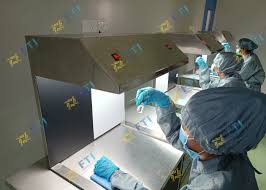 Conversion-Focused Landing Pages – More Leads, Less Bounce!
Conversion-Focused Landing Pages – More Leads, Less Bounce!
Comprehensive Guide on Visual Inspection Guidelines in India: Key Standards and Criteria
Written by Business News » Updated on: January 25th, 2025
Visual inspection is a crucial process in various industries, especially in pharmaceuticals and manufacturing. Ensuring the quality and safety of products through visual inspection helps maintain high standards and prevents defects from reaching consumers. In India, visual inspection is guided by several standards and practices, ensuring that industries comply with safety and quality requirements. This article will cover important aspects of Visual Inspection Guidelines in India, the role of qualified toxicologists, and the significance of particle contamination testing.
What is the IPC Standard for Visual Inspection?
The Indian Pharmacopoeia Commission (IPC) provides comprehensive guidelines for visual inspection in the pharmaceutical industry. The IPC standard ensures that injectable products are free from visible particulates and meet stringent quality requirements. According to the IPC, all parenteral products must undergo 100% visual inspection to detect any particulate matter or defects.

Key points of the IPC standard include:
• Inspection Environment: The inspection should be conducted in a well-lit area, typically with an illumination of 2000-3750 lux.
• Inspector Qualification: Inspectors should be trained and regularly evaluated to ensure they can accurately detect defects.
• Inspection Procedure: Each unit must be visually inspected against a black and white background for a few seconds.
What are the Criteria for a Visual Inspection?
Criteria for visual inspection are essential to ensure consistency and reliability in detecting defects. In general, visual inspection criteria include:
1. Clarity and Cleanliness: The product must be free from visible particles, cloudiness, or discoloration.
2. Container Integrity: The container should not have any cracks, chips, or other forms of damage.
3. Seal Integrity: The seals and closures should be intact and secure.
4. Label Accuracy: Labels should be correctly positioned and free from smudges or errors.
5. Fill Level: The product should be filled to the correct level without overfilling or underfilling.
What is the Standard for Visual Inspection?
The standard for visual inspection can vary by industry, but in pharmaceuticals, the World Health Organization (WHO) and the International Society for Pharmaceutical Engineering (ISPE) provide globally recognized standards. In India, the following standards are commonly referenced:
• Good Manufacturing Practices (GMP): Outlined by the WHO, GMP standards require visual inspection as part of quality control processes.
• Indian Pharmacopoeia (IP): Provides specific guidelines on visual inspection for injectable and ophthalmic products.
These standards emphasize the importance of consistency in inspection methods, the use of appropriate lighting and background, and the regular training of inspectors.
What is the AQL Limit for Visual Inspection?
Acceptable Quality Limit (AQL) refers to the maximum number of defective items considered acceptable during random sampling of a batch. In visual inspection, the AQL limit helps determine the sample size and the number of allowable defects.
For pharmaceuticals, typical AQL limits for visual inspection might include:
• Critical Defects: AQL 0.1% (e.g., cracks or leaks in containers)
• Major Defects: AQL 0.65% (e.g., particulate contamination)
• Minor Defects: AQL 1.5% (e.g., cosmetic issues)
AQL limits are determined based on the severity of defects and the potential risk they pose to consumers. The inspection process follows specific sampling plans, such as ANSI/ASQ Z1.4 standards, to ensure systematic evaluation.
The Role of Qualified Toxicologists in India
Qualified toxicologists play a vital role in ensuring the safety and efficacy of pharmaceutical products. In India, toxicologists are responsible for assessing the potential risks associated with contaminants and ensuring that products comply with safety standards. Their expertise helps in:
• Risk Assessment: Identifying and evaluating the potential health risks of impurities or contaminants.
• Regulatory Compliance: Ensuring that products meet the safety standards set by regulatory bodies like the Central Drugs Standard Control Organization (CDSCO).
• Product Development: Advising on safe levels of exposure to chemicals and helping design safer products.
Importance of Particle Contamination Testing in India
Particle Contamination Testing is critical in industries like pharmaceuticals and electronics, where even minor contamination can affect product quality and safety. In India, stringent regulations require thorough particle contamination testing to ensure product integrity.
Key aspects of particle contamination testing include:
• Testing Methods: Techniques like light obscuration, microscopic examination, and membrane filtration are commonly used.
• Regulatory Standards: Products must meet the limits specified in standards such as the Indian Pharmacopoeia (IP) and International Organization for Standardization (ISO) guidelines.
• Quality Assurance: Regular testing helps maintain consistent product quality and prevents contamination-related issues.
Conclusion
Adhering to visual inspection guidelines in India is crucial for maintaining product quality and safety. Understanding the IPC standards, inspection criteria, AQL limits, and the role of qualified toxicologists ensures that industries can meet regulatory requirements and deliver safe products to consumers. Additionally, particle contamination testing remains an essential part of quality control, helping detect and prevent potential defects. By following these guidelines and standards, companies in India can uphold high-quality standards and protect public health.
Disclaimer: We do not promote, endorse, or advertise betting, gambling, casinos, or any related activities. Any engagement in such activities is at your own risk, and we hold no responsibility for any financial or personal losses incurred. Our platform is a publisher only and does not claim ownership of any content, links, or images unless explicitly stated. We do not create, verify, or guarantee the accuracy, legality, or originality of third-party content. Content may be contributed by guest authors or sponsored, and we assume no liability for its authenticity or any consequences arising from its use. If you believe any content or images infringe on your copyright, please contact us at [email protected] for immediate removal.
Copyright © 2019-2025 IndiBlogHub.com. All rights reserved. Hosted on DigitalOcean for fast, reliable performance.






